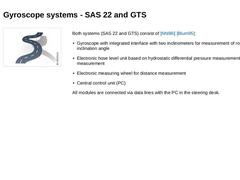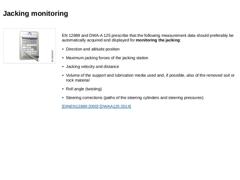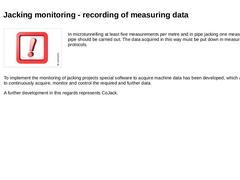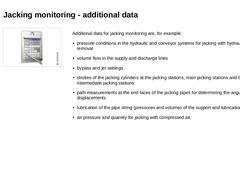
|

|
From DN/ID 1000, measurement systems with North seeking gyroscopes offer the possibility of determining the precise direction and position of the microtunnelling or shield machine in the man-accessible nominal size region without line of sight connection being available [Irmsc95] [NN93a]. |
|
System for alignment and steering in pipe jacking
SAS 22 (Image: Gyroscope installed in the shield machine (box in centre of picture) with altitude sensor (box … |
|

|

(Image: Steerable techniques) Both systems (SAS 22 and GTS) consist of [NN98i] [Blum95]: -
Gyroscope with integrated interface with two inclinometers for measurement of rolling and inclination angle
-
Electronic hose level unit based on hydrostatic differential pressure measurement for elevation measurement
-
Electronic measuring wheel for distance measurement
-
Central control unit (PC)
All modules are connected via data lines with the PC in the steering … |

|

|

|

|
(Image: Documentation) |
EN 12889 and DWA-A 125 prescribe that the following measurement data should preferably be automatically acquired and displayed for monitoring the jacking: -
Direction and altitude position
-
Maximum jacking forces of the jacking station
-
Jacking velocity and distance
-
Volume of the support and lubrication media used and, if possible, also of the removed soil or rock material
-
Roll angle (twisting)
-
Steering corrections (paths …
|
|

|

| (Image: Attention!)
In microtunnelling at least five measurements per metre and in pipe jacking one measuring per pipe should be carried out. The data acquired in this way must be put down in measurement protocols. | |
To implement the monitoring of jacking projects special software to acquire machine data has been developed, which are able to continuously acquire, monitor and control the required and further data. A further development in this regards … |
|

|

Additional data for jacking monitoring are, for example: -
pressure conditions in the hydraulic and conveyor systems for jacking with hydraulic spoil removal
-
volume flow in the supply and discharge lines
-
bypass and jet settings
-
strokes of the jacking cylinders at the jacking stations, main jacking stations and the intermediate jacking stations
-
path measurements at the end faces of the jacking pipes for determining the angular …
|

|

|

|

|
(Image: CoJack - Logo)
CoJack (Computing and Controlling Pipe-Jacking) is a comprehensive instrument for planning, monitoring and quality assurance of jacking projects. It reduces the risk factor of an overstraining of the pipes during jacking and thus decisively increases the safety and economic efficiency of jacking projects. CoJack allows for a continuous updating of the structural calculation by means of a correction of the permissible jacking … |
|

|

CoJack takes the most important input parameters, which have a great influence on the pipe load and which have been neglected in current calculation methods, into account: -
non-linear stiffness behaviour (elastic and plastic deformation proportions) of the pressure transfer ring, which can be determined individually for any jacking project in a lab test
-
load history of the pressure transfer ring at any point in time of the jacking project
-
changes …
|
|

|

|
(Image: Planning) |
Before the construction works (planning): -
check of the structural calculations of the jacking pipes
-
determination of the safety level under the given circumstances (planning data)
-
optimised dimensioning of the jacking pipes
-
configuration of the jacking works
|
|
|
(Image: Construction site) |
Construction works: -
prevention of damages
-
ensuring of a smooth construction process
|
|
|
(Image: Inspection) |
Construction approval:… |
|
|

|

(Image: CoJack - sequence diagramm of simulation) |

|

In the monitoring of the running jacking works, CoJack requires precise and up-to-date measuring values from the construction site. (Image: Procedure of the online-simulation of pipe jacking - NEU) (Table: Areas of application for a monitoring / supervision of a pipe jacking project) For this purpose a Gap Measurement System (GMS) has been developed especially according to CoJack's requirements, whose sensors continuously and automatically … |

|

The measurement system works completely independent from the installed steering guidance system and can thus be installed at any construction site directly after the start of the jacking works. Usually the sensors consist of: -
distance meters to measure the joint gap
-
pressure sensors to measure the pressure at the jacking station
-
distance meters to measure the extension of the jacking station
-
measuring wheel to determine the covered jacking distance
|

|

All measurement data are transmitted to the system computer via data cable and Controller Unit and are displayed there. The system creates a data base, in which the single sensor values and/or the openings of the recorded gaps and the present jacking forces generated by the jacking station and interjacks are consistently documented including the corresponding extensions. Via an on-line connection CoJack is supplied with these up-to-date measuring … |

|

The functional principle and application of CoJack is shown in the diagram (right). The interaction with the construction site is made possible by signal light concept. The 'signal light' represents a practical, simplified illustration of the results. Basically, jacking measures simulated via CoJack can be categorised in 4 case groups according to Table below. (Image: Functional principle and application of CoJack) (Table: Case groups of the simulation … |

|

|
(Image: Pros and cons) |
CoJack allows for -
greater jacking distances,
-
tighter curve radii and
-
higher jacking speeds.
This leads to immense savings, e.g. by: -
saving of jacking shafts
-
saving of otherwise geometrically required shafts and
-
reduction of the construction time.
|
|

|

|

|

This presentation is part of the series of presentations "Utility Tunnelling" and deals with the fundamentals in steering, measurement and monitoring of pipe jacking projects. |

|

Today, supply and discharge lines are still predominantly installed by using the open-cut method: a trench is dug, the lines are installed. Under the protection of an embankment or sheeting and the trench is filled afterwards. In the face of the numerous disadvantages as well as the citizens' growing environmental consciousness in the future it is urgently necessary to take trenchless technology into account much stronger than until today as an alternative … |

|

|
(Image: Simple hand shield - working face with natural support) |
Hand shields are non-mechanised open shield machines in which the soil at the working face is loosened by hand using auxiliary tools (pickaxe, spades, shovels or pneumatic hammer). The removal of the spoil is carried out with the aid of conveyor belts, transport carts or tracked conveying buckets (dump trucks). |
|
|
|
Examples: |
(Image: Hand shield (external diameter 4672) with working … |
|
|

|

(Table: Classification of hand shields according to the type of working face support [FI-Steina]) |
|

|

(Video: Open face shield (Tunnel Boring Machine) – dissmantling of the working face with axial cutter head (roadheader)) (Image: Attention!) Natural support of the working face is always applicable when the existing subsoil is free of groundwater and the working face is a priori stable (working face without support) or is sufficiently supported by a self-forming earth wedge with a natural slope angle. Thanks to the Epping Group for providing the video! |

|

(Image: Attention!)With partial support, the surface of the working face is divided into sections and is either supported by means of natural partial support on bench plates (bench (plate) or platform shields) and/or by means of mechanical partial support using breast plates. (Image: Hand shield with breast plates - working face with mechanical partial support) (Image: Hand shield with benches (Bench shield) - working face with natural partial support) (… |

|

|
(Image: Attention!)
Shield machines with partial excavation by hand are predominantly used for: -
short jacking distances under 50 m
-
crossings of traffic ways
-
jacking of an extraordinary cross-section
-
groundwater-free soil or rock
|
|

|

|
SM-T1 - areas of application: -
stable, cohesive soil, i.e. firm-stiff and very stiff cohesive soil (soil class LBM 2 and 3 and/or LBO 2 and 3 according to DIN 18319) with a compressive strength of approx. 1.0 N/mm2
-
Rock with uniaxial compressive strength ≥ 5 N/mm2 (classes FD 2 to 4 and/or FZ 2 to 4)
|
SM-T2 - areas of application: -
loose to densely compacted non-cohesive soil (classes LNE 1 to 3 and/or LNW 1 to 3) with a particle size concentration < …
|
|